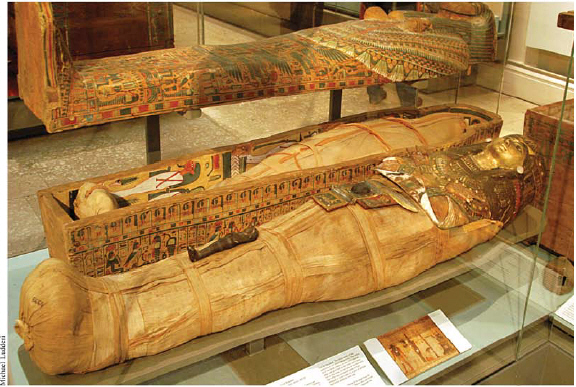Joseph in Egypt -- By: Charles F. Aling
Journal: Bible and Spade (Second Run)
Volume: BSPADE 16:3 (Summer 2003)
Article: Joseph in Egypt
Author: Charles F. Aling
BSpade 16:3 (Summer 2003) p. 89
Joseph in Egypt

Sixth of Six Parts
We do not know how many years Joseph served as Egypt’s Vizier (Prime Minister). It is very interesting that he evidently held two key title, Vizier and Chief Steward of the King. This relatively unusual in Egyptian history.
Significantly, the best known examples come from the Middle Kingdom, exactly the period of Joseph’s career. While none of the known officials holding these two posts can be identified with Joseph, it is probable that he was the first to do so and set a precedent.

Embalmed mummies from Thebes, Egypt. Right: mummy of Katabet, ca. 1300 BC; above left, mummy of an unidentified woman and painted wooden coffin, 950–900 BC. British Museum, London.
BSpade 16:3 (Summer 2003) p. 90

Canopic jars in which the wrapped organs of the dead were placed, British Museum, London. The jars were then deposited in the tomb along with the mummified body.
Two deaths are recoded near the end of the Book of Genesis, that of Jacob and of Joseph himself. Both men were embalmed, or mummified. Today, the popular view is that this was a mysterious process about which we know little or nothing. Such is not the case. With the large number of mummies preserved in museums, we would be poor scientists indeed if we could not reconstruct this procedure. What then were the basics of mummification? (see Adams 1984, and on the popular level, Davis 1986)
Two things were essential to the mummification process. First, the body was dried. A great deal was accomplished in this regard by the naturally dry climate of Egypt. I remember seeing a photograph of a Roman soldier who had died in Egypt and who had been buried in the sand without any kind of embalming treatment at all. His hair was well preserved, as were his teeth, and there was a good deal of skin remaining, too. The Egyptians aided this natural drying process, however. They packed the body with a powdery substance called natron (basically sodium carbonate and sodium bi-carbonates). This chemical is found naturally in several locations in Egypt (Lucas 1962:263ff.).
It is important to realize that a liquid solution was not used, but rather that the body was packed in this dry powder for a period of many days. The exact length of time in the natron varied according to which period of Egyptian history the mummy belonged and according to the amount being spent on the process. Presumably, a rich family would spend more on pres...
Click here to subscribe
